Inupiat vs Malaysian Community Comparison
COMPARE
Inupiat
Malaysian
Social Comparison
Social Comparison
Inupiat
Malaysians
2,695
SOCIAL INDEX
24.5/ 100
SOCIAL RATING
244th/ 347
SOCIAL RANK
3,136
SOCIAL INDEX
28.9/ 100
SOCIAL RATING
232nd/ 347
SOCIAL RANK
Malaysian Integration in Inupiat Communities
The statistical analysis conducted on geographies consisting of 75,565,881 people shows a substantial positive correlation between the proportion of Malaysians within Inupiat communities in the United States with a correlation coefficient (R) of 0.568. On average, for every 1% (one percent) increase in Inupiat within a typical geography, there is an increase of 0.076% in Malaysians. To illustrate, in a geography comprising of 100,000 individuals, a rise of 1,000 Inupiat corresponds to an increase of 76.3 Malaysians.
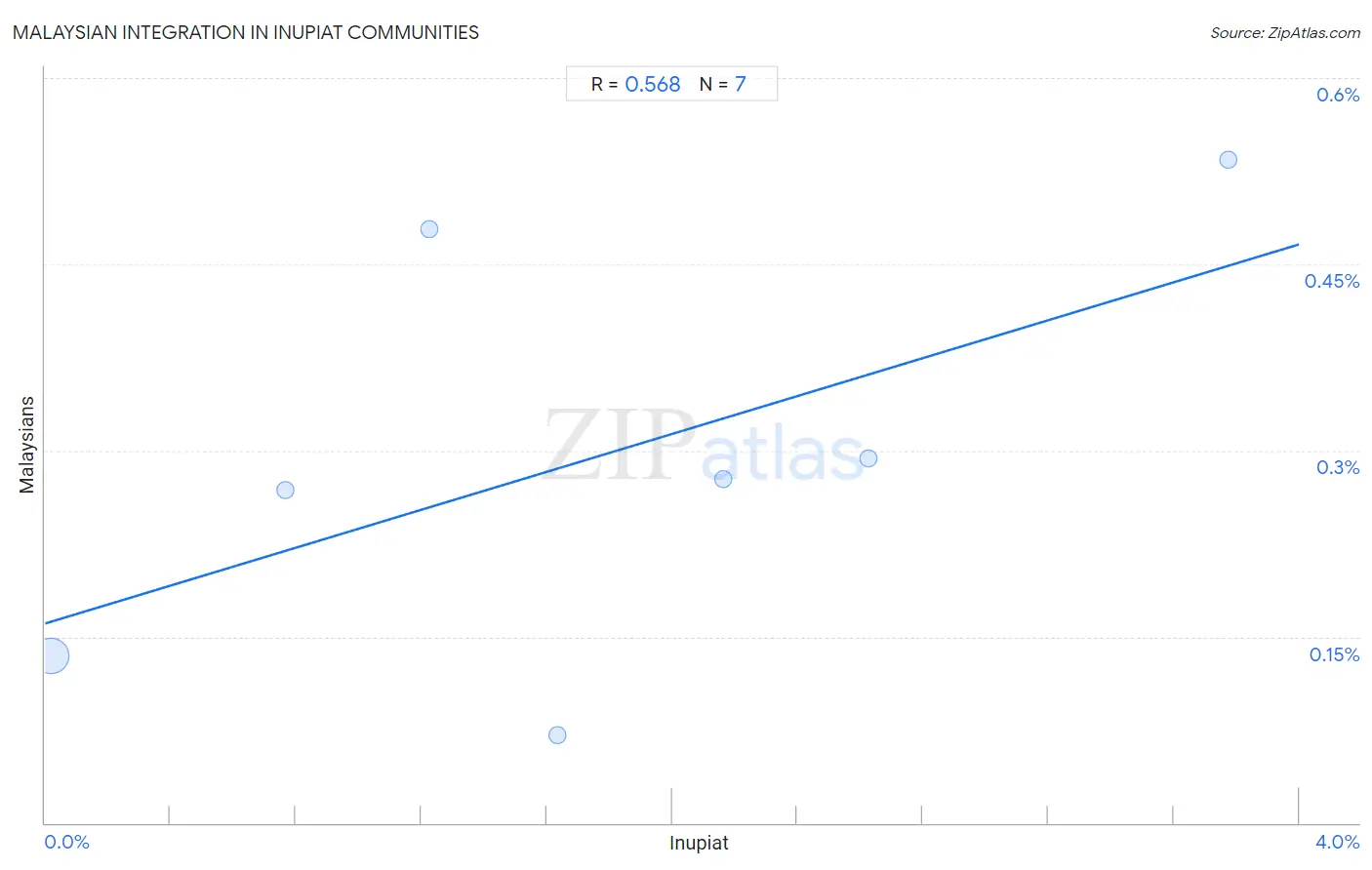
Inupiat vs Malaysian Income
When considering income, the most significant differences between Inupiat and Malaysian communities in the United States are seen in wage/income gap (20.8% compared to 25.0%, a difference of 20.6%), householder income under 25 years ($55,935 compared to $51,615, a difference of 8.4%), and median female earnings ($40,080 compared to $37,298, a difference of 7.5%). Conversely, both communities are more comparable in terms of median earnings ($43,000 compared to $43,844, a difference of 2.0%), median household income ($78,841 compared to $81,064, a difference of 2.8%), and householder income ages 45 - 64 years ($91,355 compared to $94,517, a difference of 3.5%).

| Income Metric | Inupiat | Malaysian |
| Per Capita Income | Tragic $36,999 | Tragic $39,194 |
| Median Family Income | Tragic $91,730 | Tragic $95,230 |
| Median Household Income | Tragic $78,841 | Tragic $81,064 |
| Median Earnings | Tragic $43,000 | Tragic $43,844 |
| Median Male Earnings | Tragic $47,281 | Tragic $50,772 |
| Median Female Earnings | Good $40,080 | Tragic $37,298 |
| Householder Age | Under 25 years | Exceptional $55,935 | Poor $51,615 |
| Householder Age | 25 - 44 years | Tragic $84,619 | Tragic $88,291 |
| Householder Age | 45 - 64 years | Tragic $91,355 | Tragic $94,517 |
| Householder Age | Over 65 years | Average $61,061 | Tragic $58,244 |
| Wage/Income Gap | Exceptional 20.8% | Excellent 25.0% |
Inupiat vs Malaysian Poverty
When considering poverty, the most significant differences between Inupiat and Malaysian communities in the United States are seen in single male poverty (20.0% compared to 12.6%, a difference of 58.5%), receiving food stamps (20.1% compared to 12.7%, a difference of 57.7%), and married-couple family poverty (7.1% compared to 5.4%, a difference of 33.5%). Conversely, both communities are more comparable in terms of single mother poverty (29.0% compared to 29.7%, a difference of 2.4%), child poverty among boys under 16 (18.1% compared to 17.6%, a difference of 2.8%), and single female poverty (23.1% compared to 22.2%, a difference of 4.3%).
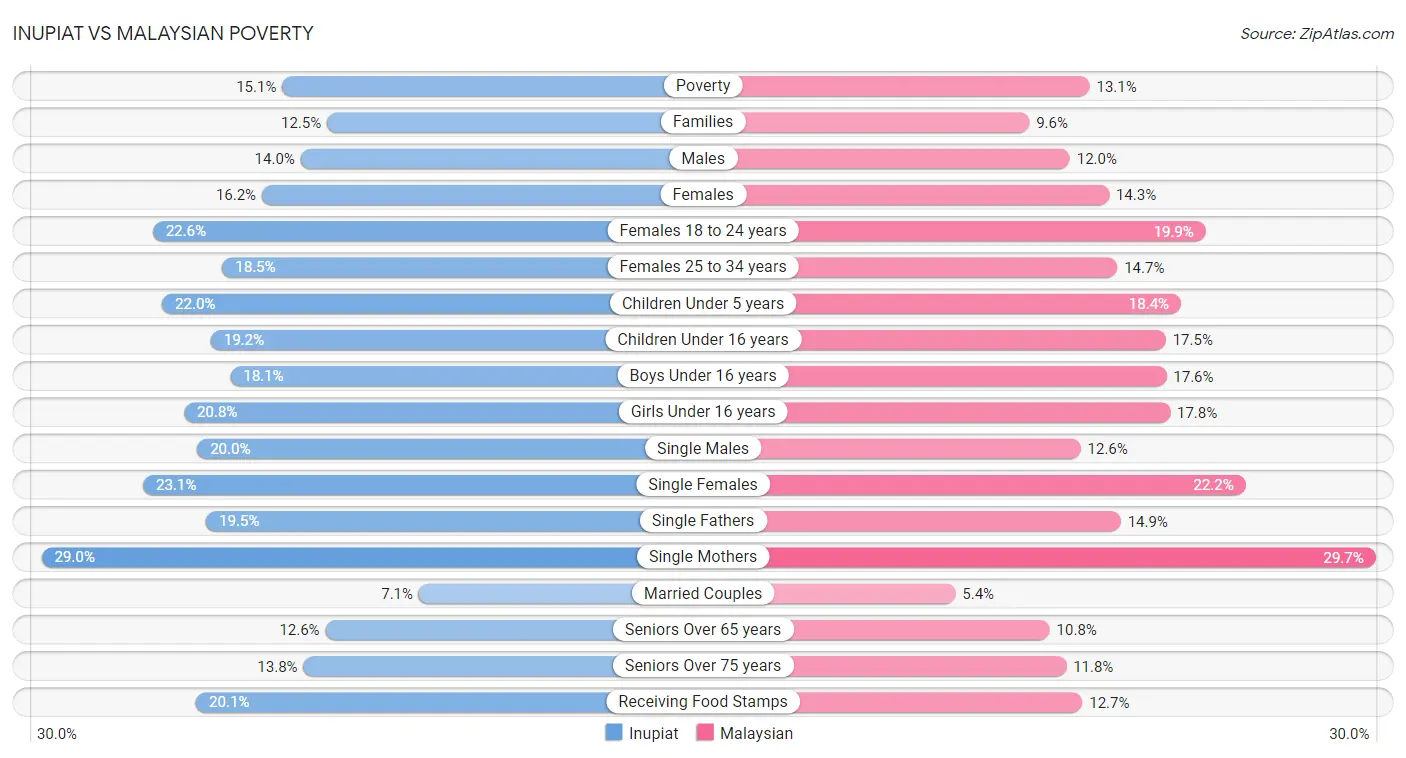
| Poverty Metric | Inupiat | Malaysian |
| Poverty | Tragic 15.1% | Tragic 13.1% |
| Families | Tragic 12.5% | Poor 9.6% |
| Males | Tragic 14.0% | Tragic 12.0% |
| Females | Tragic 16.2% | Tragic 14.3% |
| Females 18 to 24 years | Tragic 22.6% | Good 19.9% |
| Females 25 to 34 years | Tragic 18.5% | Tragic 14.7% |
| Children Under 5 years | Tragic 22.0% | Tragic 18.4% |
| Children Under 16 years | Tragic 19.2% | Tragic 17.5% |
| Boys Under 16 years | Tragic 18.1% | Tragic 17.6% |
| Girls Under 16 years | Tragic 20.8% | Tragic 17.8% |
| Single Males | Tragic 20.0% | Good 12.6% |
| Single Females | Tragic 23.1% | Tragic 22.2% |
| Single Fathers | Tragic 19.5% | Exceptional 14.9% |
| Single Mothers | Good 29.0% | Poor 29.7% |
| Married Couples | Tragic 7.1% | Fair 5.4% |
| Seniors Over 65 years | Tragic 12.6% | Good 10.8% |
| Seniors Over 75 years | Tragic 13.8% | Excellent 11.8% |
| Receiving Food Stamps | Tragic 20.1% | Tragic 12.7% |
Inupiat vs Malaysian Unemployment
When considering unemployment, the most significant differences between Inupiat and Malaysian communities in the United States are seen in unemployment among women with children under 6 years (17.7% compared to 7.7%, a difference of 128.5%), male unemployment (12.1% compared to 5.3%, a difference of 126.7%), and unemployment among ages 20 to 24 years (20.9% compared to 9.8%, a difference of 113.1%). Conversely, both communities are more comparable in terms of unemployment among seniors over 75 years (9.1% compared to 8.9%, a difference of 2.2%), unemployment among seniors over 65 years (5.8% compared to 5.1%, a difference of 15.4%), and unemployment among ages 65 to 74 years (7.5% compared to 5.2%, a difference of 43.2%).
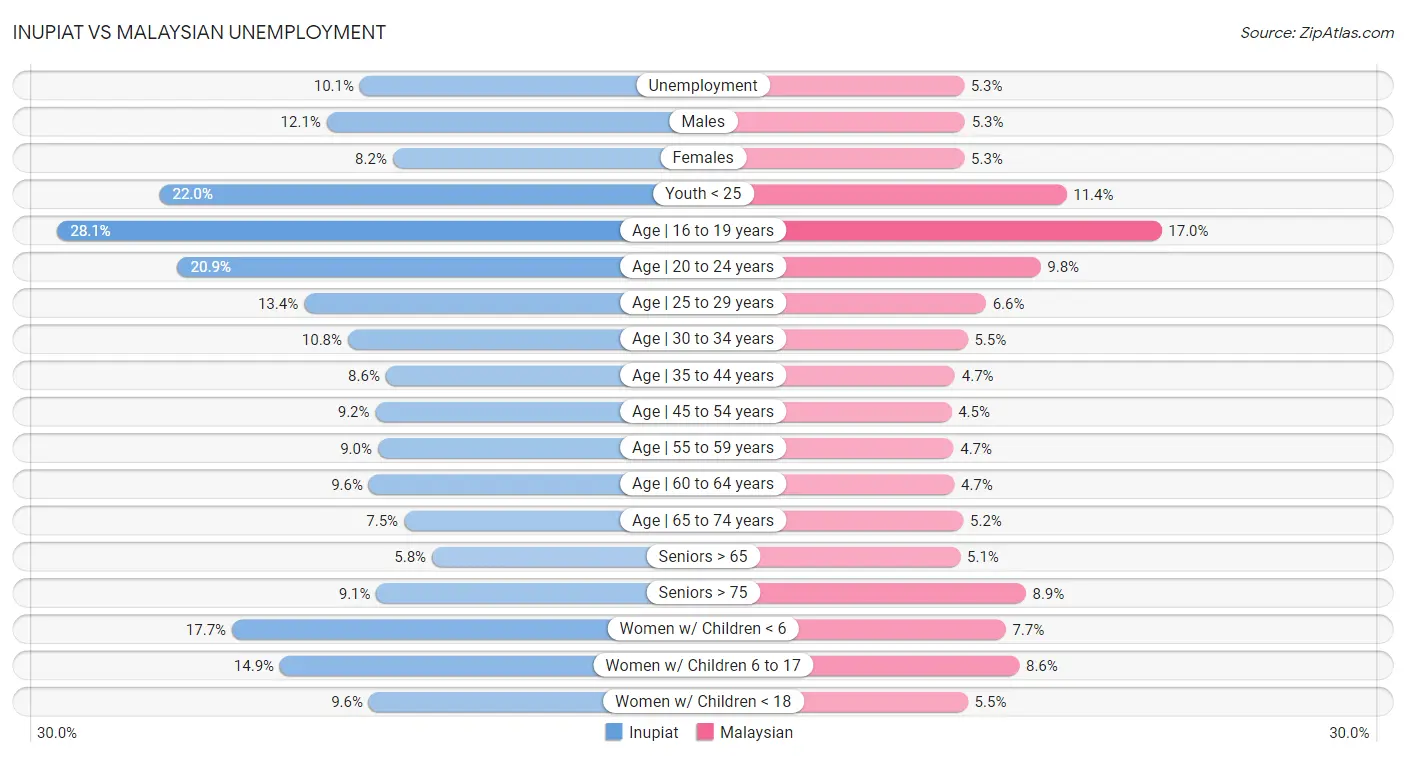
| Unemployment Metric | Inupiat | Malaysian |
| Unemployment | Tragic 10.1% | Average 5.3% |
| Males | Tragic 12.1% | Fair 5.3% |
| Females | Tragic 8.2% | Average 5.3% |
| Youth < 25 | Tragic 22.0% | Excellent 11.4% |
| Age | 16 to 19 years | Tragic 28.1% | Exceptional 17.0% |
| Age | 20 to 24 years | Tragic 20.9% | Exceptional 9.8% |
| Age | 25 to 29 years | Tragic 13.4% | Good 6.6% |
| Age | 30 to 34 years | Tragic 10.8% | Average 5.5% |
| Age | 35 to 44 years | Tragic 8.6% | Fair 4.7% |
| Age | 45 to 54 years | Tragic 9.2% | Average 4.5% |
| Age | 55 to 59 years | Tragic 9.0% | Exceptional 4.7% |
| Age | 60 to 64 years | Tragic 9.6% | Exceptional 4.7% |
| Age | 65 to 74 years | Tragic 7.5% | Exceptional 5.2% |
| Seniors > 65 | Tragic 5.8% | Exceptional 5.1% |
| Seniors > 75 | Tragic 9.1% | Poor 8.9% |
| Women w/ Children < 6 | Tragic 17.7% | Fair 7.7% |
| Women w/ Children 6 to 17 | Tragic 14.9% | Exceptional 8.6% |
| Women w/ Children < 18 | Tragic 9.6% | Fair 5.5% |
Inupiat vs Malaysian Labor Participation
When considering labor participation, the most significant differences between Inupiat and Malaysian communities in the United States are seen in in labor force | age 16-19 (35.0% compared to 39.7%, a difference of 13.5%), in labor force | age 25-29 (79.8% compared to 84.6%, a difference of 6.1%), and in labor force | age 30-34 (79.7% compared to 84.1%, a difference of 5.5%). Conversely, both communities are more comparable in terms of in labor force | age 45-54 (79.9% compared to 82.0%, a difference of 2.7%), in labor force | age > 16 (64.3% compared to 66.1%, a difference of 2.9%), and in labor force | age 35-44 (80.9% compared to 83.8%, a difference of 3.5%).

| Labor Participation Metric | Inupiat | Malaysian |
| In Labor Force | Age > 16 | Tragic 64.3% | Exceptional 66.1% |
| In Labor Force | Age 20-64 | Tragic 76.1% | Fair 79.5% |
| In Labor Force | Age 16-19 | Tragic 35.0% | Exceptional 39.7% |
| In Labor Force | Age 20-24 | Poor 74.6% | Exceptional 77.2% |
| In Labor Force | Age 25-29 | Tragic 79.8% | Average 84.6% |
| In Labor Force | Age 30-34 | Tragic 79.7% | Tragic 84.1% |
| In Labor Force | Age 35-44 | Tragic 80.9% | Tragic 83.8% |
| In Labor Force | Age 45-54 | Tragic 79.9% | Tragic 82.0% |
Inupiat vs Malaysian Family Structure
When considering family structure, the most significant differences between Inupiat and Malaysian communities in the United States are seen in single father households (4.9% compared to 2.7%, a difference of 78.1%), births to unmarried women (52.1% compared to 33.9%, a difference of 53.8%), and single mother households (8.5% compared to 7.3%, a difference of 16.1%). Conversely, both communities are more comparable in terms of family households (67.8% compared to 65.9%, a difference of 2.9%), divorced or separated (11.4% compared to 12.4%, a difference of 8.2%), and married-couple households (42.4% compared to 46.3%, a difference of 9.2%).

| Family Structure Metric | Inupiat | Malaysian |
| Family Households | Exceptional 67.8% | Exceptional 65.9% |
| Family Households with Children | Exceptional 32.8% | Exceptional 29.8% |
| Married-couple Households | Tragic 42.4% | Average 46.3% |
| Average Family Size | Exceptional 3.63 | Exceptional 3.31 |
| Single Father Households | Tragic 4.9% | Tragic 2.7% |
| Single Mother Households | Tragic 8.5% | Tragic 7.3% |
| Currently Married | Tragic 41.3% | Poor 45.9% |
| Divorced or Separated | Exceptional 11.4% | Tragic 12.4% |
| Births to Unmarried Women | Tragic 52.1% | Tragic 33.9% |
Inupiat vs Malaysian Vehicle Availability
When considering vehicle availability, the most significant differences between Inupiat and Malaysian communities in the United States are seen in no vehicles in household (29.9% compared to 7.7%, a difference of 287.5%), 2 or more vehicles in household (42.6% compared to 59.8%, a difference of 40.4%), and 3 or more vehicles in household (16.9% compared to 22.6%, a difference of 34.2%). Conversely, both communities are more comparable in terms of 4 or more vehicles in household (6.2% compared to 7.7%, a difference of 23.7%), 1 or more vehicles in household (71.5% compared to 92.3%, a difference of 29.0%), and 3 or more vehicles in household (16.9% compared to 22.6%, a difference of 34.2%).

| Vehicle Availability Metric | Inupiat | Malaysian |
| No Vehicles Available | Tragic 29.9% | Exceptional 7.7% |
| 1+ Vehicles Available | Tragic 71.5% | Exceptional 92.3% |
| 2+ Vehicles Available | Tragic 42.6% | Exceptional 59.8% |
| 3+ Vehicles Available | Tragic 16.9% | Exceptional 22.6% |
| 4+ Vehicles Available | Fair 6.2% | Exceptional 7.7% |
Inupiat vs Malaysian Education Level
When considering education level, the most significant differences between Inupiat and Malaysian communities in the United States are seen in no schooling completed (1.5% compared to 2.8%, a difference of 81.8%), associate's degree (32.6% compared to 41.6%, a difference of 27.9%), and bachelor's degree (25.8% compared to 32.9%, a difference of 27.6%). Conversely, both communities are more comparable in terms of ged/equivalency (83.1% compared to 83.3%, a difference of 0.23%), 12th grade, no diploma (90.1% compared to 89.2%, a difference of 0.93%), and nursery school (98.9% compared to 97.3%, a difference of 1.7%).
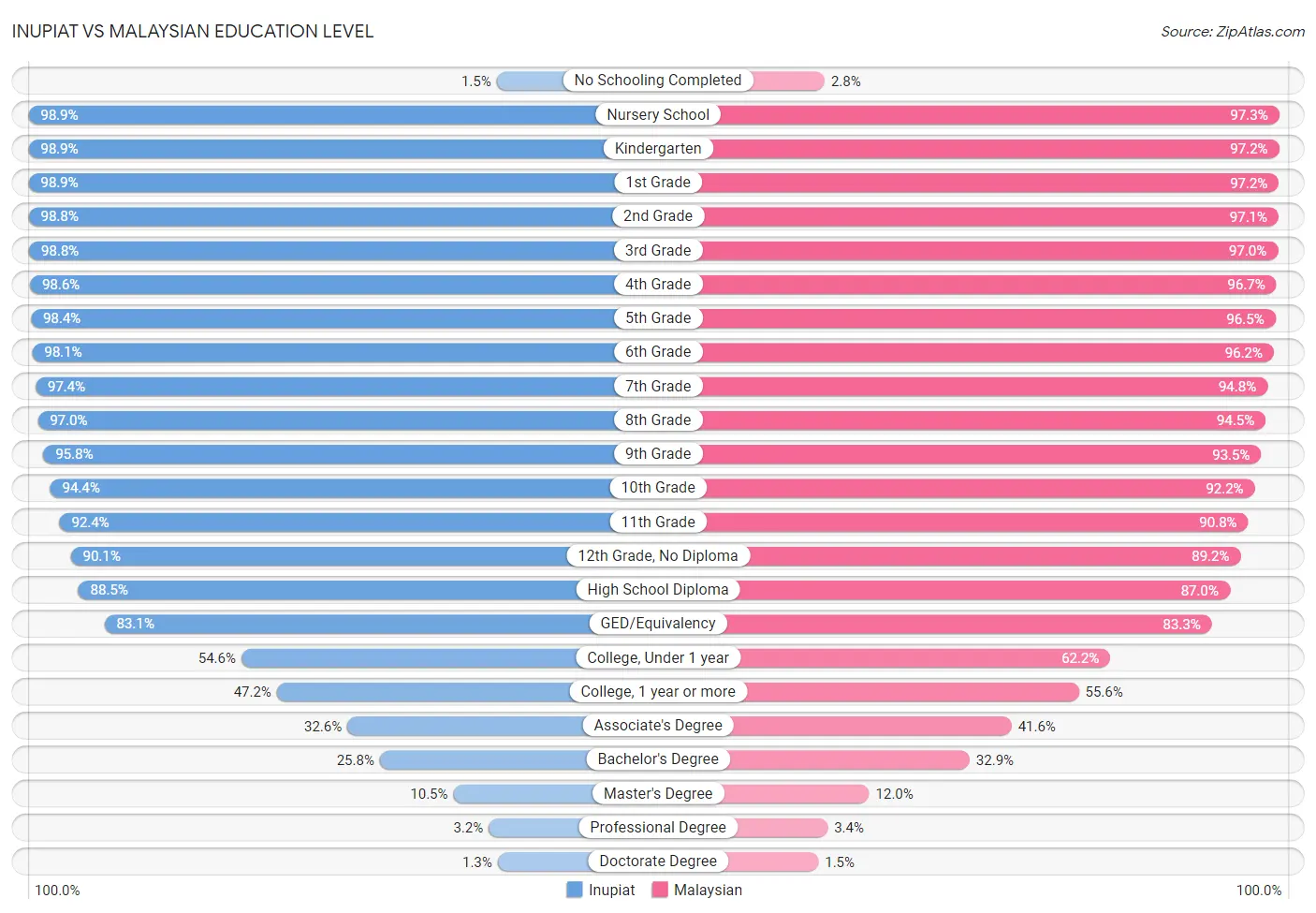
| Education Level Metric | Inupiat | Malaysian |
| No Schooling Completed | Exceptional 1.5% | Tragic 2.8% |
| Nursery School | Exceptional 98.9% | Tragic 97.3% |
| Kindergarten | Exceptional 98.9% | Tragic 97.2% |
| 1st Grade | Exceptional 98.9% | Tragic 97.2% |
| 2nd Grade | Exceptional 98.8% | Tragic 97.1% |
| 3rd Grade | Exceptional 98.8% | Tragic 97.0% |
| 4th Grade | Exceptional 98.6% | Tragic 96.7% |
| 5th Grade | Exceptional 98.4% | Tragic 96.5% |
| 6th Grade | Exceptional 98.1% | Tragic 96.2% |
| 7th Grade | Exceptional 97.4% | Tragic 94.8% |
| 8th Grade | Exceptional 97.0% | Tragic 94.5% |
| 9th Grade | Exceptional 95.8% | Tragic 93.5% |
| 10th Grade | Exceptional 94.4% | Tragic 92.2% |
| 11th Grade | Average 92.4% | Tragic 90.8% |
| 12th Grade, No Diploma | Tragic 90.1% | Tragic 89.2% |
| High School Diploma | Poor 88.5% | Tragic 87.0% |
| GED/Equivalency | Tragic 83.1% | Tragic 83.3% |
| College, Under 1 year | Tragic 54.6% | Tragic 62.2% |
| College, 1 year or more | Tragic 47.2% | Tragic 55.6% |
| Associate's Degree | Tragic 32.6% | Tragic 41.6% |
| Bachelor's Degree | Tragic 25.8% | Tragic 32.9% |
| Master's Degree | Tragic 10.5% | Tragic 12.0% |
| Professional Degree | Tragic 3.2% | Tragic 3.4% |
| Doctorate Degree | Tragic 1.3% | Tragic 1.5% |
Inupiat vs Malaysian Disability
When considering disability, the most significant differences between Inupiat and Malaysian communities in the United States are seen in disability age under 5 (3.7% compared to 1.3%, a difference of 187.0%), hearing disability (4.7% compared to 3.2%, a difference of 48.2%), and disability age 65 to 74 (34.5% compared to 25.4%, a difference of 36.0%). Conversely, both communities are more comparable in terms of disability (12.2% compared to 12.2%, a difference of 0.11%), disability age 5 to 17 (5.7% compared to 5.8%, a difference of 2.6%), and cognitive disability (16.9% compared to 17.9%, a difference of 6.1%).
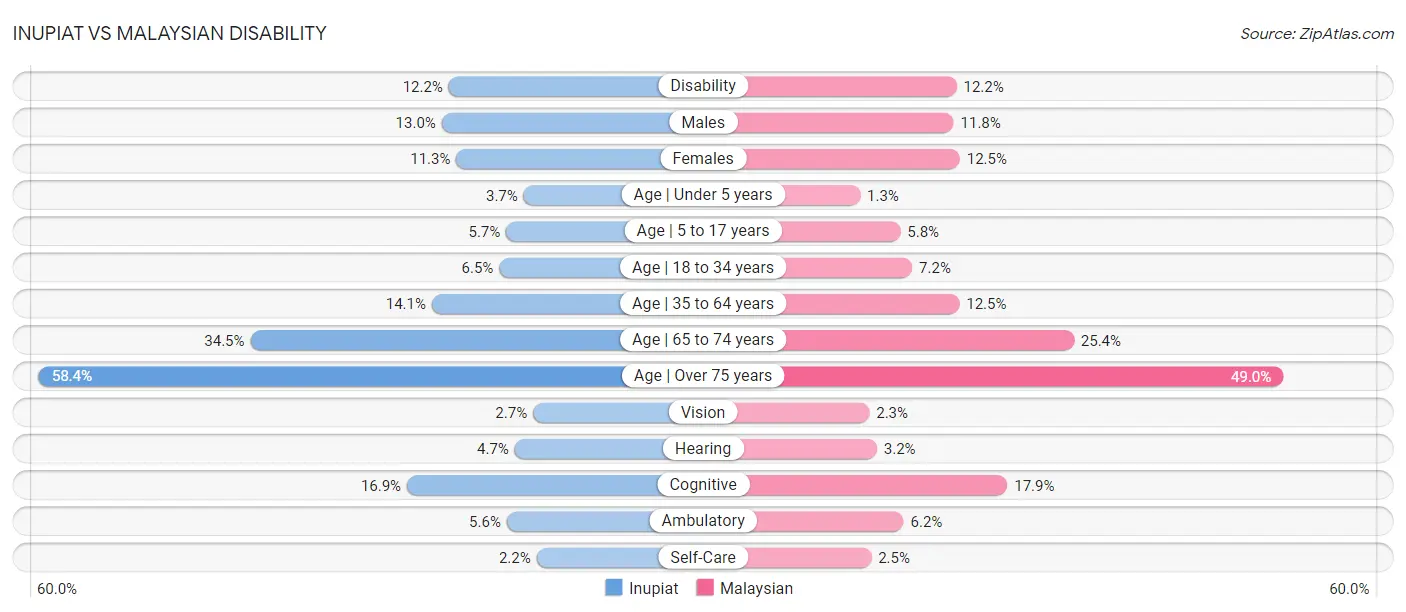
| Disability Metric | Inupiat | Malaysian |
| Disability | Tragic 12.2% | Tragic 12.2% |
| Males | Tragic 13.0% | Tragic 11.8% |
| Females | Exceptional 11.3% | Tragic 12.5% |
| Age | Under 5 years | Tragic 3.7% | Poor 1.3% |
| Age | 5 to 17 years | Fair 5.7% | Tragic 5.8% |
| Age | 18 to 34 years | Good 6.5% | Tragic 7.2% |
| Age | 35 to 64 years | Tragic 14.1% | Tragic 12.5% |
| Age | 65 to 74 years | Tragic 34.5% | Tragic 25.4% |
| Age | Over 75 years | Tragic 58.4% | Tragic 49.0% |
| Vision | Tragic 2.7% | Tragic 2.3% |
| Hearing | Tragic 4.7% | Tragic 3.2% |
| Cognitive | Exceptional 16.9% | Tragic 17.9% |
| Ambulatory | Exceptional 5.6% | Fair 6.2% |
| Self-Care | Exceptional 2.2% | Tragic 2.5% |